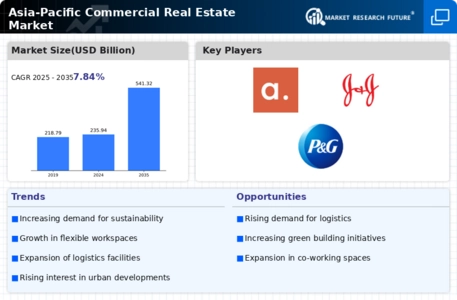Top Industry Leaders in the Asia Pacific Commercial Real Estate Market
The Asia-Pacific Commercial Real Estate Market encompasses the buying, selling, leasing, and development of commercial properties such as office buildings, retail spaces, and industrial facilities across the Asia-Pacific region. This market reflects the dynamic nature of urbanization, economic growth, and changing business landscapes in key Asia-Pacific markets.
Asia Pacific Commercial Real Estate MarketFactors Influencing Market Share
Several factors determine a company's market share in this competitive arena:
-
Financial Strength: Deep pockets allow for strategic acquisitions and development of large-scale projects, giving established players an edge. -
Diversification: Companies with a presence across multiple property types and geographies can weather economic downturns better. -
Innovation: Early adoption of PropTech solutions for property management, tenant engagement, and data analytics can lead to a competitive advantage. -
Sustainability: A focus on developing and managing green buildings is becoming increasingly important to attract tenants and investors.
Competitive Strategies:
Companies in the APAC commercial real estate market employ various strategies to gain a foothold:
-
Market Specialization: Focusing on specific niches like co-working spaces (Awfis) or cold storage facilities (Prologis) allows for targeted expertise and brand recognition. -
Geographic Expansion: Established players are venturing into new territories within the region, like CDL (Singapore) expanding its development portfolio in India. -
Technological Integration: Embracing PropTech solutions for property management, marketing, and tenant services can streamline operations and enhance customer experience. -
Sustainability Initiatives: Developing and managing green buildings with energy-efficient features and certifications like LEED attracts environmentally conscious tenants and investors.
Key Companies in the Asia-Pacific Commercial Real Estate market include
- DLF Ltd.
- Godrej Properties Ltd.
- Housing Development and Infrastructure Ltd (HDIL)
- Oberoi Realty
- IndiaBulls Real Estate
- Prestige Estate Projects Ltd
- Supertech Limited
- HDIL Ltd
- Brigade Group
- Unitech Real Estate Pvt Ltd
- MagicBricks
- Acres
- Sulekha Properties
- RE/MAX India
- JLL India
- Anarock Property Consultants
- Awfis
Industry News
January 2024: E-commerce giant Alibaba announces plans to invest USD 1 billion in developing logistics parks across Southeast Asia, signaling the continued rise of the logistics sector .
February 2024: Vacancy rates in prime office locations of major Chinese cities like Shanghai and Beijing show a slight increase, indicating a potential correction in the previously overheated market
March 2024: Increased co-working space utilization rates across India suggest a growing preference for flexible work arrangements, prompting developers to consider incorporating more co-working areas in future projects









